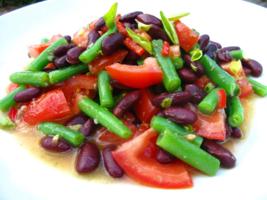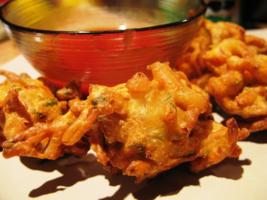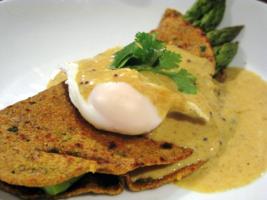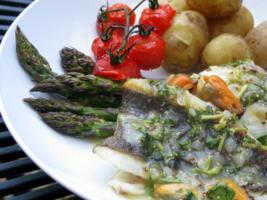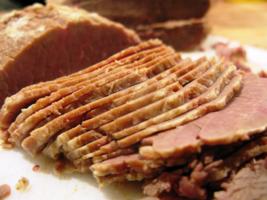I think I may have mentioned in an earlier post, my weird obsessiveness around the number three...
My alarm goes off at 07:09... or occasionally 06:57. I'm eternally greatful that our time system is base 60... cook for 30 seconds, 15 minutes, 45 seconds, lovely... I even make friends' coffee with three 2/3 teaspoons of coffee instead of just 2!
Now... are you still there? I'm not that weird, honest - it's just one of my little quirks ;) I can skip it if I need to... I'd just rather not!
It's not just me - Chinese people consider the number three to be lucky because it sounds like the word 'alive'. And in many other cultures, it is considered a significant number due to the trinity of mind, body and soul.
So anyway, I love that the Royal Foodie Joust has three ingredients, and this month I decided to propogate the three-love by using the three ingredients to make three fingerfoods and three dipping sauces!
The three ingredients were selected this month by Peter of Kalofagas fame, who won last month's joust with this amazing Apricot and Pistachio Cake. He chose Seafood, Sesame and Cilantro/Coriander - as soon as I read the list I knew I was going to have fun with this one!

The first of the three is seared marinated tuna (in the middle!), coated with crushed coriander, szechuan pepper corns and sesame seeds. I served this with a thick tahini dressing, complete with a garlicky cilantro swirl.
Secondly, for your delectation, I present sesame-crusted squid (on the right!) with a cilantro and chili yoghurt dipping sauce.
Last, but by no means least - crispy fried wontons (on the left!) with a spicy fish and prawn mousse filling, served with sweet cilantro chili dipping sauce.
I had so much fun thinking up and making these dishes - I hope you like them!

- 4 tbsp soy sauce
- 2 tbsp rice wine
- 1 tbsp mirin
- 1/2 tsp sesame oil
- 1 tsp grated ginger
- 1 crushed garlic clove
- 3 tbsp sesame seeds, lightly toasted
- 3 tbsp coriander seeds
- 1 tbsp szechaun pepper corns
- 2 thick tuna steaks
- ground nut oil for searing
- 1/3 cup sesame seeds (for the tahini)
- Extra virgin olive oil
- Large handful cilantro
- 2 clove garlic, crushed
- 1 tsp rice wine
- salt and pepper to taste
- Zest and juice of half a lemon
Mix together the sesame oil, soy, rice wine and mirin with the garlic and ginger.
Cut each tuna steak into long thick strips (give 'em three, four sides or more - your call!) and add to the marinade. Coat well and refrigerate for 30-60 minutes.
Make the Tahini Sauce...
Take the third of a cup of sesame seeds and toast in a dry pan for 3/4 minutes - being sure to keep them moving and not over-colour.
Once cooled, place them in a mini-blender and blend until smooth. Slowly add the EV olive oil until the sauce is still really thick but not like glue!
Add the lemon juice, 1 tsp rice wine, 1 clove of garlic and salt and pepper to taste. Blend again - it should now be a p
 ourable texture (if not add a little water to loosen).
ourable texture (if not add a little water to loosen).Make the Cilantro Swirl...
In the mini-blender (time-saving secret - I didn't bother washing mine from the tahini ;) place the cilantro, garlic and lemon zest and blend til smooth. Add olive oil until it reaches a pourable consistency.
Cook the Tuna...
Once the tuna has finished marinating, remove it from the fridge.
Pound the coriander seeds and szechuan together until coarsely ground. Place this mixture onto one plate - and the toasted sesame seeds onto another.
Remove the tuna from the marinade and coat each length in either the sesame seeds or the spice mix.
Heat a little oil in a very hot pan, and sear the tuna for no more than a minute on each side - the centre should still be very pink!
Serve!
Slice the tuna and arrange on serving dish with the tahini cilantro dipping sauce.

- 1 medium squid, cleaned
- oil for deep frying
- 1 cup milk
- 3 tbsp sesame seeds, toasted and cooled
- 4 tbsp cornflour
- 1 tbsp plain flour
- 1 tsp ground coriander
- 1 large handful cilantro
- 1 green chili
- 3/4 cup natural yogurt
- 2/3 drops of sesame oil
- lemon juice, sugar, salt and pepper to taste
Prepare the Squid...
Cut the squid into strips and gently criss cross the inside to create a hatch pattern.
Place into the milk and refrigerate for 2 hours.
Mix the corn flour, flour and sesame seeds together in a food bag.
Once the squid has soaked, remove from the milk, shaking off the excess, then place in the bag. Shake bag thoroughly until the squid is well coated.
Remove the squid from the bag and place back in the fridge for at least half an hour - this is what makes the batter so crunchy!

Make the Sauce...
In a mixer, blend the cilantro and the chili together until fairly smooth. Turn out to a bowl and add the coriander and the yoghurt. Mix well, then add lemon juice, sugar, salt and pepper to taste.
Refrigerate until required.
Cook the Squid...
Heat the oil until a cube of bread browns in 30 seconds.
Gently drop the squid in - shaking to separate, and being sure not to overcrowd the pan.
Cook for approximately 45 seconds, then remove and drain on some kitchen paper.
Serve with the chili cilantro dipping sauce, and enjoy!

- 300g white fish (I used cod!)
- 100g prawns
- 1 tsp sesame oil
- 12 wonton wrappers
- 2" piece ginger, finely chopped or grated
- 2 cloves of garlic, crushed
- 2 tsp fish sauce
- Zest of 1 lime
- 2 thai red chillies, finely chopped
- 2 egg whites
- 50 ml rice vinegar
- 50 ml water
- 75g sugar
- 1 tsp cornflour
- 1 tsp sesame seeds, lightly toasted
- Soy sauce to taste
This made way more fish mousse than required - but can be used for great leftovers!
Prepare the Fish Mousse...
In a food processor, blitz the white fish until pretty smooth. Add one egg white, one chili, half the ginger, half the garlic, the lime zest, sesame oil and half the fish sauce and blitz again until it becomes 'spongey'.
Roughly chop the prawns and mix into the fish mixture with a spoon or your fingers. (Don't blend this time - we want the prawns to remain fairly intact!)
 Prepare the Sauce...
Prepare the Sauce...In a mini-blender, blend the other half of the ginger, the other half of the garlic, one chili and a handful of cilantro until finely chopped but not totally pureed.
In a small pan, bring the rice vinegar/ water and sugar to the boil and simmer for 10 minutes. Mix the cornflour with a spot of water then add to the syrup, with the ginger/garlic mix and a couple of drops of sesame oil. Simmer for another minute or so and remove from the heat.
Prepare The Wontons...
Whisk together one egg white with a little water.
Place a wonton wrapper on a lightly floured surface and brush with the egg white mixture. Place a small teaspoon of filling in the middle and fold over, gently squeezing out all the air and pressing the edges together. Make into a shape if you want - I just kinda folded the long corners in and stuck them togther... I had a crazy idea about pan-frying the seam with a sesame seed mix. Which didn't work out - more on that in a sec!
Place in a steamer (make sure they aren't touching!!)
Cook the Wontons...
Once they are all prepared, steam for 4-5 minutes, then remove from the heat...
... right, so it was at his point that things started to go wrong... some of my wontons were touching - and when I tried to separate them the wrapper tore...
Emergency re-think required. My original thought had been to coat two side of the wonton in sesame seeds and pan-fry for a minute or two to give a lovely crunchy edge. But that wasn't going to work with my poor little torn wontons... So, noticing that my oil was nicely hot I decided to briefly deep-fry them instead!
Woo hoo - they were delicious! Make sure the oil is really nice and hot - these have already been cooked, we're just crisping them up. Fry for a minute or two then drain on kitchen paper.
Serve!
With a squeeze of lime juice and sweet chili and cilantro sauce!
